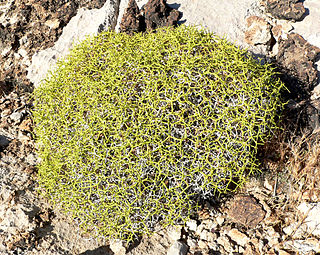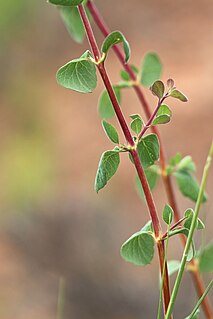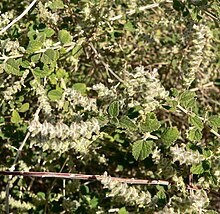
Cucurbita digitata is a species of flowering plant in the squash family known by the common names fingerleaf gourd and bitter squash. It is similar to Cucurbita californica, Cucurbita cordata, Cucurbita cylindrata, and Cucurbita palmata and all these species hybridize readily. These species form the only restricted xerophyte species group in the genus Cucurbita. Each member of this species group is native to the Southwestern United States and Northwestern Mexico where they are relatively uncommon. Each group member is found in hot, arid regions with low rainfall. They prefer soil that is loose, gravelly, and well-drained. C. digitata is native to northern Baja California at higher elevations, northern Sonora, Mexico, southern Arizona, and southwestern New Mexico. The juvenile leaves of C. cylindrata, C. cordata, C. digitata, and C. palmata show a high degree of similarity, but their mature leaves are visibly different, as are their root structures. C. palmata and C. digitata are sympatric, with C. palmata separating the ranges of C. digitata at the juncture of Baja California, California, and Arizona. C. digitata fruits are clear green mottle that turns yellow at maturity, striped, and round.

Eriogonum deflexum is a species of wild buckwheat known by the common names flatcrown buckwheat, flat-top buckwheat, and skeletonweed. This plant is native to the southwestern United States and northwestern Mexico, where it is common and grows in a variety of habitats, especially desert scrub. It is somewhat weedy where it is most abundant. This is an annual which varies in size from small patches on the ground to tangled bushes approaching two meters in height; it may be dense or thin and spindly. This is a brown or greenish weedy-looking herb with a many-branched stem. The leaves are located at the base of the plant and are rounded and woolly and one to four centimeters long. Small clusters of flowers appear at intervals along the branches with each flower only one to three millimeters wide and white or pinkish in color.

Eriogonum heermannii is a species of wild buckwheat known by the common name Heermann's buckwheat. It is native to the southwestern United States from California to Utah where it grows on rocky slopes, desert flats, and dry washes.

Eschscholzia glyptosperma is a species of poppy known by the common names desert gold poppy, desert golden poppy, and Mojave poppy.

Fallugia is a monotypic genus of flowering plants containing the single species Fallugia paradoxa, which is known by the common names Apache plume and póñil. This plant is native to the southwestern United States and northern Mexico, where it is found in arid habitats such as desert woodlands and scrub.

Abronia turbinata is a species of flowering plant in the four o'clock family known by the common name transmontane sand-verbena. It is native to eastern California and Oregon and western Nevada, where it grows in desert and plateau scrub.

Arctostaphylos glauca is a species of manzanita known by the common name bigberry manzanita. It is native to California and Baja California, where it grows in the chaparral and woodland of coastal and inland hills.

Lepidium fremontii, the desert pepperweed, is a species of flowering plant in the mustard family which is native to the southwestern United States, where it grows on sandy desert flats and the rocky slopes of nearby hills and mountains. It takes its scientific name from John C. Frémont.

Astragalus layneae is a species of milkvetch known by the common name widow's milkvetch. It is native to the Mojave Desert and surrounding mountain ridges in California and Nevada.
Boechera dispar is a species of flowering plant in the family Brassicaceae known by the common name pinyon rockcress. It is native to eastern California and western Nevada, where it grows in rocky areas in desert and mountain habitat. This is a perennial herb growing from a branching caudex. It produces several erect stems reaching 10 to 25 centimeters tall. The leaves are mostly located about the caudex. They are linear to lance-shaped, coated in white hairs, and one or two centimeters long. The flowers have purple petals. The fruit is a long, narrow, hairless silique up to 7 centimeters long containing round, winged seeds.
Phacelia mustelina is an uncommon species of phacelia known by the common names weasel phacelia and Death Valley round-leaved phacelia. It is native to the desert mountains and flats of eastern California and western Nevada, where it grows in woodland and open scrub habitat.

Physalis hederifolia is a species of flowering plant in the nightshade family known by the common name ivyleaf groundcherry. It is native to the southwestern United States and northern Mexico, where it can be found in rocky, dry desert and mountain habitat. This is a rhizomatous perennial herb producing a hairy, branching stem 10 to 80 centimeters long. The gray-green oval leaves are 2 to 4 centimeters long and have smooth or bluntly toothed edges. The flowers growing from the leaf axils are bell-shaped and just over a centimeter long. They are yellow with five brown smudges in the throats. The five-lobed calyx of sepals at the base of the flower enlarges as the fruit develops, becoming an inflated, veined nearly spherical structure 2 or 3 centimeters long which contains the berry.

Physaria chambersii is a species of flowering plant in the family Brassicaceae known by the common name Chambers' twinpod. It is native to the southwestern United States, where it grows in desert woodland and plateau habitat. It is a perennial herb growing from a taproot and producing a clumpy rosette of stems up to 15 centimeters long, growing erect and falling over in fruit. The plant is covered in a silver-white coat of hairs. The leaves in the rosette are rounded to oval, up to 6 centimeters long by 2 wide, and smaller, spoon-shaped leaves are located along the stems. The inflorescence is a raceme of four-petalled golden yellow flowers. The fruit is an inflated pod which may be over a centimeter long. It is notched and divided into two chambers, each containing 4 seeds.

Porophyllum gracile is a species of flowering plant in the aster family known by the common names odora and slender poreleaf. It is native to northern Mexico and the southwestern United States from California to Texas, where it can be found in rocky and sandy desert scrub habitat.

Acleisanthes nevadensis is a species of flowering plant in the four o'clock family known by the common names desert moonpod and desert wing-fruit. It is native to a section of the southwestern United States encompassing southern Nevada and adjacent corners of Utah and Arizona. One occurrence has been observed in eastern California. The plant grows in desert habitat such as scrub and rocky washes. This herb produces several spreading stems up to about 30 centimeters in maximum length, sometimes from a woody base. The stems are covered in many leaves with fleshy oval or rounded blades up to 3 centimeters long which are borne on petioles. The herbage of the plant is coated in thick, wide, white, furry hairs, interspersed with shorter, flat hairs. Some hairs are glandular. Flowers occur in leaf axils. Each is a trumpet-shaped bloom with a narrow, tubular green throat up to 4 centimeters long and a round white corolla face about a centimeter wide, sometimes tinged yellow or greenish. There are five long, protruding stamens and a long style tipped with a spherical stigma. The fruit is a ribbed, hairy body with five broad, white wings.

Symphoricarpos longiflorus is a species of flowering plant in the honeysuckle family known by the common names desert snowberry and fragrant snowberry. It is native to the western United States from the Great Basin to western Texas, as well as northwestern Mexico.
Tetradymia argyraea is a species of flowering plant in the aster family known by the common names striped cottonthorn and striped horsebrush. It is native to the desert mountains of the southwestern United States, particularly of California, Nevada, and Arizona, where it grows in desert woodland habitat. It is a woolly, spiny shrub growing one half to nearly two meters in maximum height. The erect stems are white-woolly except for bare stripes at intervals. The leaves are linear in shape and harden as they age, becoming spiny. The larger leaves are woolly and there are clusters of smaller, threadlike leaves which may be hairless. The inflorescence bears two to five flower heads which are each enveloped in five thick phyllaries coated in white woolly hairs. Each head contains five pale yellow flowers each around a centimeter long. Flowers are produced in summer, as late as September. The fruit is an achene a few millimeters long tipped with a pappus of bristles.

Trianthema portulacastrum is a species of flowering plant in the ice plant family known by the common names desert horsepurslane, black pigweed, and giant pigweed. It is native to areas of several continents, including Africa and North and South America, and present as an introduced species in many other areas. It grows in a wide variety of habitat types and it can easily take hold in disturbed areas and cultivated land as a weed. It is an annual herb forming a prostrate mat or clump with stems up to a meter long. It is green to red in color, hairless except for small lines of hairs near the leaves, and fleshy. The leaves have small round or oval blades up to 4 centimeters long borne on short petioles. Solitary flowers occur in leaf axils. The flower lacks petals but has purple, petallike sepals. The fruit is a curved, cylindrical capsule emerging from the stem. It is up to half a centimeter long and has two erect, pointed wings on top, where the capsule opens.

Physaria tenella is a species of flowering plant in the family Brassicaceae known by the common names Moapa bladderpod and slender bladderpod. It is native to western North America from Utah to Sonora, where it grows mainly in desert habitat. This is an annual herb producing several hairy multibranched erect to spreading stems sometimes exceeding half a meter long. The basal leaves are up to 6.5 centimeters long and sometimes toothed, and there are smaller leaves higher on the stem. The inflorescence is a raceme of flowers at the tip of the stem. The mustardlike flower has four orange to bright yellow petals each up to a centimeter long. The fruit is a plump, hairy, rounded capsule.

Ottleya strigosa, synonyms Lotus strigosus and Acmispon strigosus, is a flowering plant in the pea family (Fabaceae), native to the southwestern United States and northern Mexico. It is known as stiff-haired lotus or strigose bird's-foot trefoil.

















